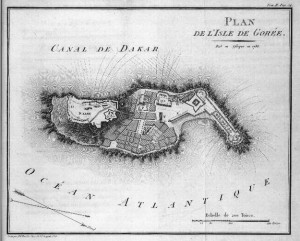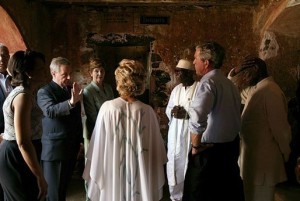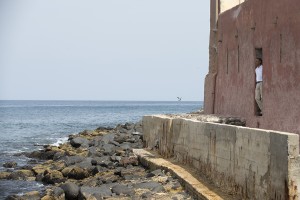By David Romine
As the first sitting Republican president to visit Africa, President George W. Bush’s speech in Senegal seemed to be more for the benefit of an American audience than an African one. Standing safely out of the noonday July sun on the Isle of Gorée, Bush declared that “At this place liberty and life were stolen and sold. Human beings were delivered and sorted, and weighed, and branded with the marks of commercial enterprises, and loaded as cargo on a voyage without return. One of the largest migrations of history was also one of the greatest crimes of history.” [1]
Acknowledging the violent, dehumanizing history of the transatlantic slave trade at this particular site was by no means accidental. Gorée Island has since the 1990s served as a site of pilgrimage which has become almost de rigueur for visiting presidents, religious leaders, and dignitaries. Among those to speak there since its designation as a site of “Outstanding Universal Value” by UNESCO in 1978 are Nelson Mandela, Barack Obama, Pope John Paul II, and Bill Clinton. Gorée has joined the ranks of Cape Coast Castle and São Jorge de Mina as sites of remembrance for the horrors of the slave trade by members of the African diaspora.[2]
At only 45 acres, the main attraction on the island is the Maison des Esclaves, or the House of Slaves, its pink outer walls concealing an austere interior. Since 1962, the site has been maintained by a museum founded by Boubacar Joseph Ndiaye in order to preserve the historical significance of the island. Tours take visitors from bare room to bare room, with plaques on the walls, commemorating the millions who passed through the halls of this house and the estimated dozen or so others on the island, culminating in the la porte du voyage sans retour (the door of no return). The door itself, a plain affair on the ground floor, opens directly onto a short, rocky beach and then to the sea. As a potent symbol in the memorialization of the slave trade, the door is described in literature and tourist narratives as the final portal Africans passed through on their way to death and suffering in the New World. It was the beginning of the Middle Passage for millions of men, women, and children.
And yet, as early as 1959, French historians were questioning the idea that the Island of Gorée was a major transshipment point for African slaves. In 1995, Atlantic slave trade historian Philip D. Curtin publicly stated that Gorée was never important in the slave trade and the following year the French historian Emmanuel de Ru lamented in an article in Le Monde that the “myth” of the House of slaves survived by being “resistant to reality.”[3] Archeologists have weighed in, as historical anthropologist François Richard of the University of Chicago argued that the Maison des Esclaves itself “would not have been a commercial point or processing center for slaves.” The lack of literature documenting voyages to and from Gorée is the primary factor for historians’ conclusions, but the island’s small size and lack of infrastructure or apparent evidence of slave trading has led most to conclude that slaves on Gorée resided there in the houses of their owners. In other words, Gorée was not a major site of slave-trading, but a colonial outpost with slaves in residence.
The vast majority of African scholars, historians, and archeologists agree on this perspective. However, some take issue with their methodology. Ibrahim Thiaw, a Senegalese archeologist at IFAN (Institut Fondamental d’Afrique Noire), commenting on the lack of physical evidence of large numbers of slaves being housed in preparation for sale and transport, argued that chains and confinement were seldom necessary. “Captive populations don’t usually leave much behind,” Thiaw notes. “Archaeologically you won’t find much evidence that Gorée was used as a transshipment center for slaves. But it was clearly an important point in Atlantic trading patterns and, anyway what would you expect to find? Chains? The act of transshipment does not necessarily leave traces in the archaeological record.”
This debate, over the authenticity of Gorée as a site of historical memory of the slave trade, has not ceased, and with each visit by a foreign dignitary, the debate is revived again.[5] President Obama called his recent encounter with la porte du voyage sans retour to be a “very powerful moment” upon which he reflected on the history of African Americans, but a number of news outlets mentioned the site’s contested history. It is perhaps more reflective of the needs of Senegal as a state than Gorée remains a site of memorialization. Gorée’s physical location, just a short ferry ride from Dakar’s bustling port, draws thousands of tourists a year. As a memorial to the slave trade, Dakar/Gorée now resides amongst other slave castles and trading sites that draw tourists from the African Diaspora to Africa’s coast.
There are a number of questions that are raised when the site of memorialization is physically disconnected from the event (or events) being memorialized. In the case of the Maison des Esclaves, its supporters claim it to be the actual site of departure for hundreds of thousands (if not millions) of Africans bound for the New World. Even if, as Curtin claims, a “mere” 33,000 slaves (estimated) were taken from Gorée in chains, does that mean it is less of a memorial than El Mina or Cape Coast Castle? Does it obscure the suffering of those being led down to the Atlantic littoral and shipped across the ocean?
Even if it is not the actual site of departure, that fact does not change the reality of the middle passage, of the men and women and children bound in manacles and chained below decks of slave ships. Gorée’s history as an administrative site of empire implicates it in the slave trade and French colonialism, much like Liverpool or London or New York. Does it matter that Gorée is not an “authentic” slave castle? Can Gorée be a placeholder of sorts for the whole history of the transatlantic slave trade in West Africa? Perhaps there perhaps more mundane reasons for its continued popularity, for instance, its accessibility and location so close to a major African city means that it can be seen by thousands of people each year whereas other sites of the West African coast might be far more difficult to reach.
Historians are famously (notoriously) concerned about evidence for claims, perhaps to the point of pedantry, but what work does evidence do in the face of meanings derived from sites such as this? How do sincere fictions such as Gorée serve the dead in ways that no historical monograph, article, or panel presentation ever could?




